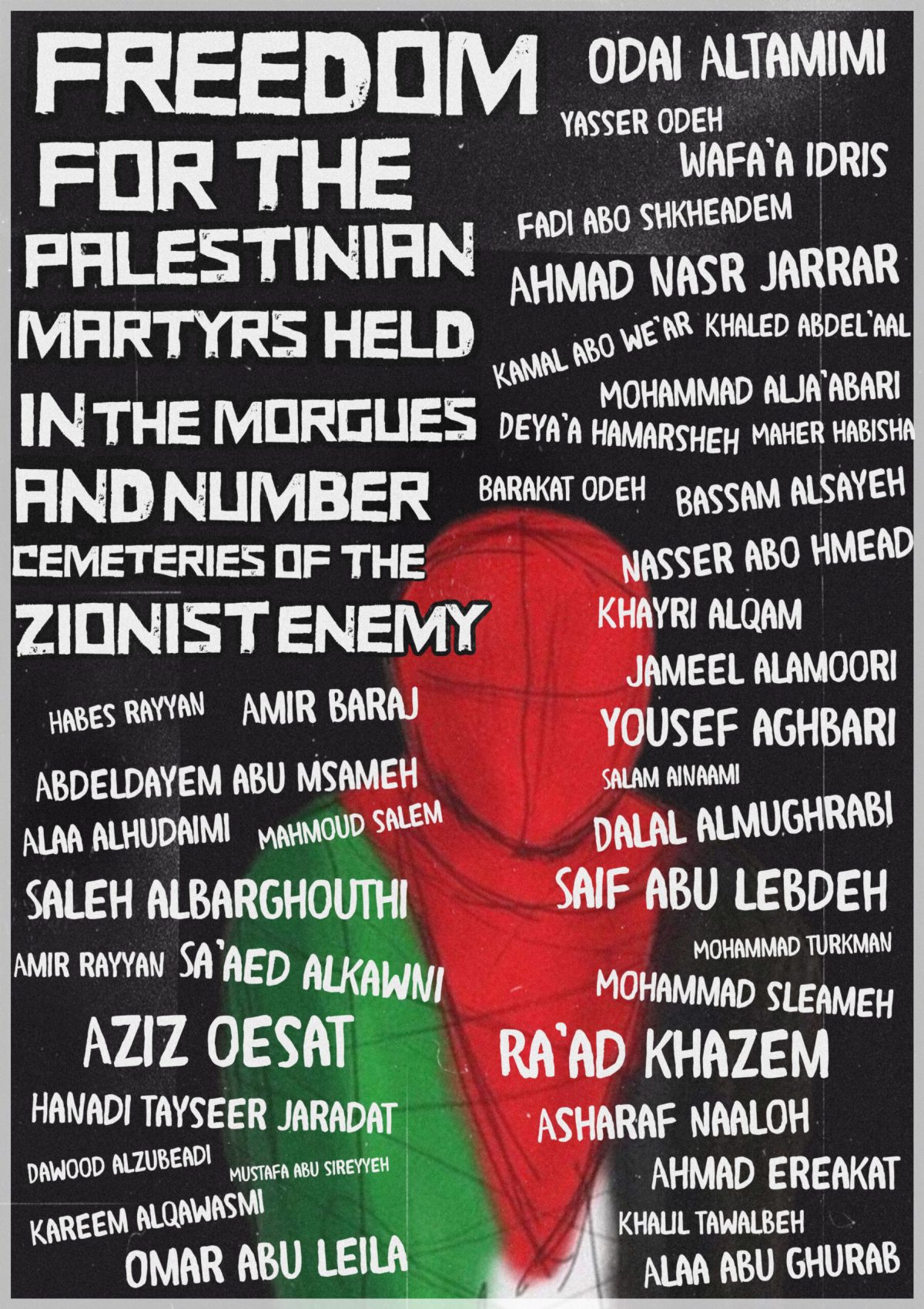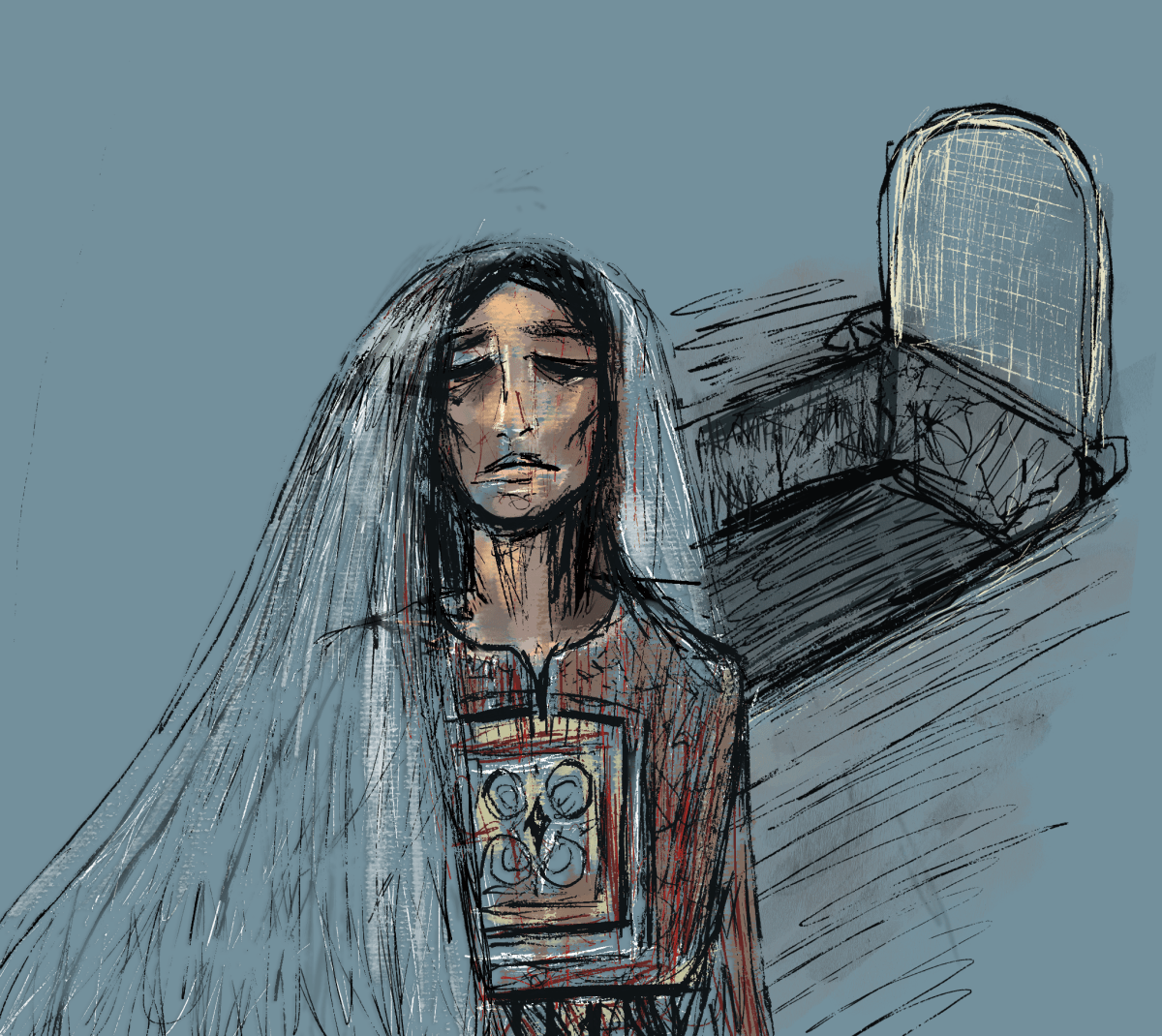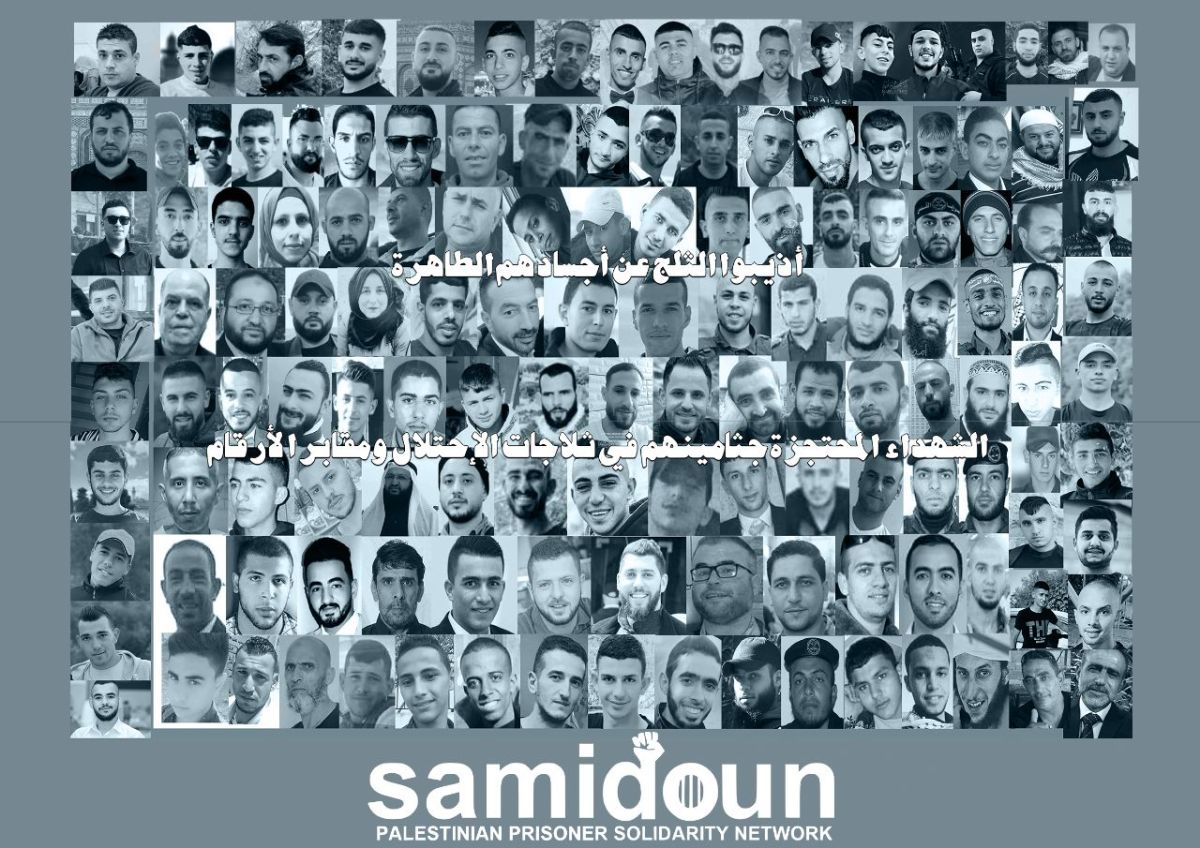
27 August is the Palestinian National Day to Reclaim the Bodies of the Detained Martyrs, when Palestinian, Arab and international voices come together to demand an end to the imprisonment of the bodies of the martyrs by the occupation.
Today, there are 256 Palestinian martyrs whose bodies are held in the “numbers cemeteries,” where Palestinians are buried with numbers and not their names, while another 142 are held in occupation morgues since 2015. They include 11 martyrs of the Palestinian prisoners’ movement — most recently, the body of Sheikh Khader Adnan, whose life was taken after 86 days of hunger strike and the occupation’s deliberate refusal to provide him with medical care — 14 children and five women.

In March of this year, Samidoun Palestinian Prisoner Solidarity Network co-launched the International Campaign to Liberate the Remains of Palestinian Martyrs, a project supported by over 150 Palestinian, Arab and international organizations.
As noted in the call for the week, “The occupation pursues a fascist policy in its treatment of the Palestinian and Arab martyrs. By refusing to give their families the opportunity to bury their loved ones, the occupation uses the remains of the martyrs as a mechanism for psychological torture of their families by detaining them for years and using them as a card for negotiation with the Palestinian resistance.
“The Palestinian people have made clear that this barbaric policy will never ‘deter’ Palestinian youth from taking part in the resistance. These martyrs remain prisoners of the occupation even after death, and their families and the Palestinian people as a whole have every right to liberate, honour and bury them in ceremonies worthy of the sacrifices they made for the cause of Palestine, for return and liberation.”
The Higher National Follow-Up Committee of the Palestinian Prisoners’ Movement issued a statement on the occasion:
The prisoners stand on this national day to raise their unified, resisting Palestinian voice to demand the recovery of the bodies of our righteous and glorious martyrs, which are kept in the so-called “graves of numbers” and the morgues of Zionist colonialism.
The prisoners are fully involved, despite their restrictions and confinement, with the national concersn and issues of our people. The issue of recovering the bodies of the martyrs is one of the most important and highest priorities amid the fierce attack of the Zionist occupation.
The occupation did not cease its practices, procedures and abusive, arbitrary policies against our struggling people, seeking to deny the Palestinian presence on our national and historic land. Instead, it seeks to liquidate all forms of life by persecuting and targeting Palestinian bodies, violating their human rights and the dignity and sanctity of the bodies of the martyrs’ bodies…
This fascist regime seeks to burn and torutre the collective, resisting Palestinian consciousness by detaining the body after killing the martyrs..depriving their relatives and people of their farewell rituals and honour on death.
Zionist colonialism expresses in these policies of death, killing and detention the same goals that it always pursues in its racist and fascist system, including the detention of the bodies of 256 martyrs in the so-called ‘numbers cemeteries’, stripping from them their names and their national and human identity.
Among these righteous martyrs is the prisoner martyr Anis Dawla, who was martyred in the Battle of Empty Stomachs during the Nafha prison strike in 1980.
In addition to the numbers cemeteries, this brutal colonizer has been imprisoning in its morgues the bodies of 142 martyrs since 2015, including 11 prisoner martyrs from the prisons of Zionist colonialism, 14 child martyrs and 5 female martyrs. This brutal regime is expressing its abhorrent intentions of detaining nearly 400 martyrs, exposing its exclusionary and fascist settler colonial project to open struggle in the fields of life and death together.
We affirm on this national day that our martyrs who are held in morgues and numbers cemeteries are our shining stars in the proud sky of Palestine. The time has come for them to truly appear in the sky of the homeland, to illuminate it with their lights of sacrifice and resistance, these lights emerging from the blood of our martyrs, those who enlightened us on the path of return and liberation of Palestine.
The imprisoned 11 martyrs of the prisoners’ movement (out of 237 martyrs whose lives were lost behind bars, many due to medical neglect and/or torture and abuse) are:
- Anis Dawla, whose body has been imprisoned since 1980
- Aziz Oweisat, whose body has been imprisoned since 2018
- Fares Baroud, whose body has been imprisoned since 2019
- Nasser Taqatqa, whose body has been imprisoned since 2019
- Bassam al-Sayeh, whose body has been imprisoned since 2019
- Saadi al-Gharably, whose body has been imprisoned since 2020
- Kamal Abu Waer, whose body has been imprisoned since 2020
- Sami al-Amour, whose body has been imprisoned since 2021
- Daoud Zubaidi, whose body has been imprisoned since 2022
- Nasser Abu Hmeid, whose body has been imprisoned since 2022
- Sheikh Khader Adnan, whose body has been detained since 2 May 2023
It is critical that we take action on an international level to popularize the campaign to liberate the bodies of the martyrs. We call on resistance organizations, Palestinian and Arab networks, solidarity groups supporting the prisoners’ struggle and boycott campaigns around the world to join us in the international campaign to recover and release the remains of Palestinian martyrs, and to expand the support and solidarity for Palestinian prisoners and martyrs everywhere around the world, for their liberation and the liberation of Palestine from the river to the sea.
Click here to endorse and support the campaign. Read the call to action in English, French, Arabic, Spanish, German, Swedish
Hold an event: You can organize stands and demonstrations, prepare seminars, distribute leaflets and hang posters, and send your activities to samidoun@samidoun.net or to our Facebook, Twitter or Instagram pages.

Related
This post was originally published on this site be sure to check out more of their content.







